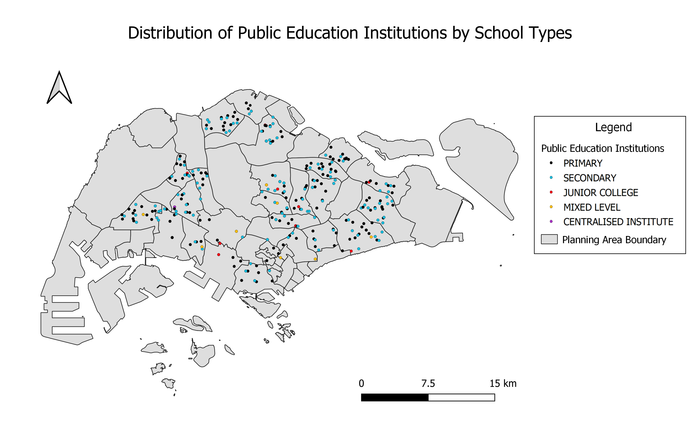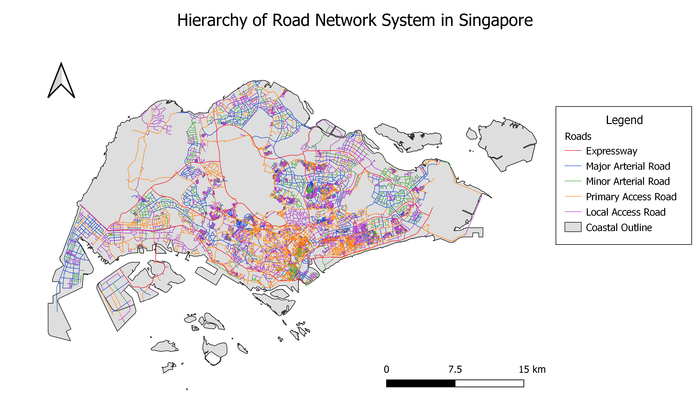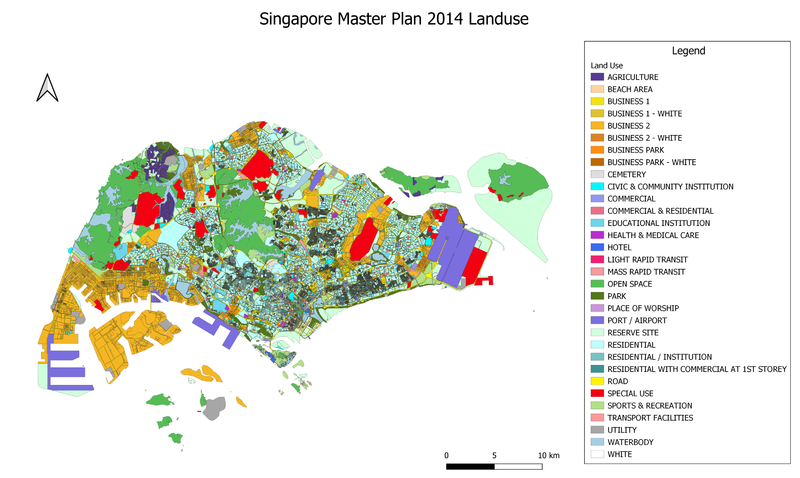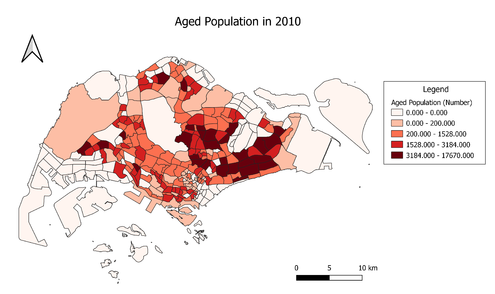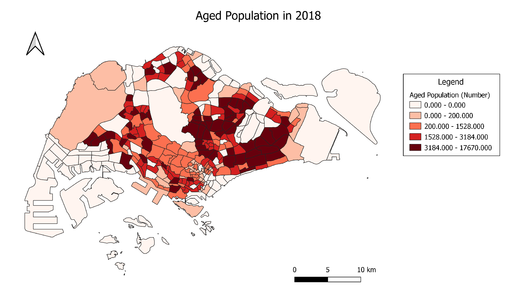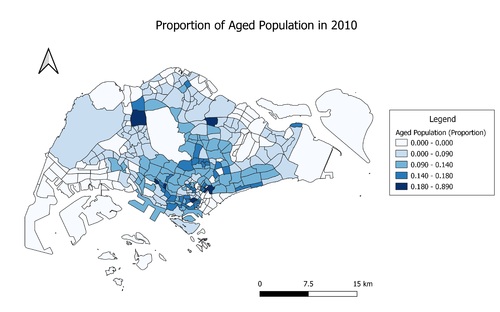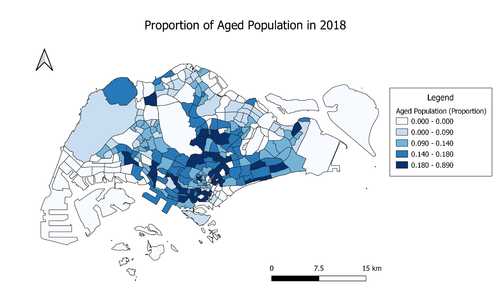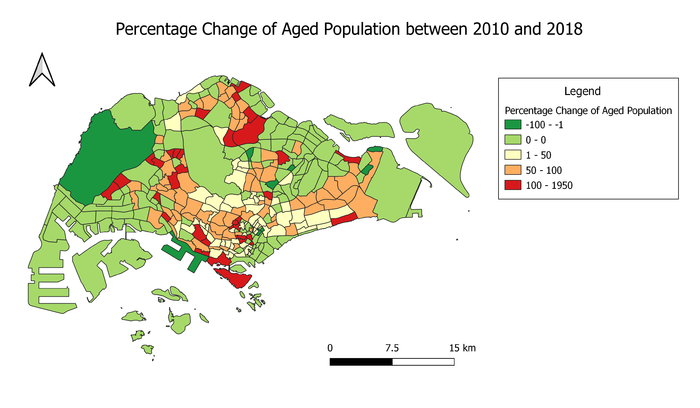SMT201 AY2019-20T1 EX1 Chong Yun Yu
Part 1: Thematic Mapping
Distribution of Public Education Institution by School Types
Data Source: General information of schools.[1]. Master Plan 2014 Planning Area Boundary (No Sea) (SHP).[2].
To show the distribution of public education institution by school type, I used the variable “mainlevel_” to categorise the datasets. This classifies all school into the different school types, namely “Primary”, “Secondary”, “Junior College”, “Mixed Level” and “Centralised Institute”. I chose to use the same symbol, a coloured circle, for all classifications. I chose a different colour for each class, as shown in the legend. Rather than using different symbols for each category, I used this method as I think it is much easier to read and understand the distribution of the institutions using different colours than shapes.
Road Network System Hierarchy of Singapore
Data Source: Road Section Line.[3]. CoastalOutline from Prof Kan’s Hands-on_Ex01.
According to the URA Handbook on Guidelines for Naming of Streets [4], roads can be classified into 5 categories. I added a new column “RD_TYPE” in the file downloaded from LTA Datamall and classified all roads into the different categories, using the URA guidelines. The 5 categories, from the highest hierarchy to the lowest hierarchy, are “Expressway”, “Major Arterial Road”, “Minor Arterial Road”, “Primary Access Road” and “Local Access Road”. I used a different colour to represent each classification, where all classification has the same line width, as shown in the legend, for better visualisation.
2014 Master Plan Landuse Singapore
Data Source: Master Plan 2014 Land Use (SHP).[5].
To show the landuse in Singapore, I used “LU_DESC”, which contains the description of land usage for each parcel of land, to classify the data. As there are 32 different categories of landuse, it is quite difficult to identify each category easily with the random colours generated by QGIS. I attempted to make the visualisation better by changing the colours to make them make more sense. For example, I used different hues of green for open spaces and parks, bright red for special use and light grey for cemetery.
Part 2: Choropleth Mapping
Aged Population (+65) in 2010 and 2018
Data Source: Singapore Residents by Planning Area/Subzone, Age Group and Sex, June 2000 – 2018 (XLS).[6]. Master Plan 2014 Subzone Boundary (No Sea) (SHP).[7]. Master Plan 2008 Subzone Boundary (No Sea) (SHP).[8].
The number of aged population increased overall in 2018, as compared to 2010. Many subzones in the East and Central regions in Singapore have more than 3184 aged persons. The number of subzones with more than 3184 aged persons more than doubled in 2018 (65 subzones) as compared to 2010 (29 subzones).
Proportion of Aged Population in 2010 and 2018
Data Source: Singapore Residents by Planning Area/Subzone, Age Group and Sex, June 2000 – 2018 (XLS).[9]. Master Plan 2014 Subzone Boundary (No Sea) (SHP).[10]. Master Plan 2008 Subzone Boundary (No Sea) (SHP).[11].
Overall, the proportion of aged population in Singapore increased in 2018, as compared to 2010. The proportion of aged population is higher in the subzones in the South region, as compared to the North region.
Percentage Change of Aged Population between 2010 and 2018
Data Source: Singapore Residents by Planning Area/Subzone, Age Group and Sex, June 2000 – 2018 (XLS).[12]. Master Plan 2014 Subzone Boundary (No Sea) (SHP).[13].
A little less than half of the subzones (139, out of 323 subzones) have no change in the aged population between 2010 and 2018. More than half of the subzones (179 subzones) have a positive change in the aged population between 2010 and 2018, which means that more than half of the subzones have an increase of aged population in 2018, as compared to 2010.
Discussion
I separated the population data from Singstat into 2 different CSV files which contains data of the population according to subzone and age in 2010 and 2018. I joined the CSV file that contains population data in 2010 to Master Plan 2008 and the one in 2018 to Master Plan 2014 to match the number of subzones. I added a new variable “aged_ab_65” to both the joined tables to store the number of aged population in each subzone. I calculated it by summing the total population of 65 and above together. I also added another new variable “prop_ab_65” to both the joined tables, which stores the calculated proportion of aged population (total aged population/total population = “aged_ab_65”/ “2018-spr-s”) in each subzone, rounded up to 2 decimals. I calculated the percentage change of aged population between 2010 and 2018 in the new variable “change1018” by joining both CSV files to Master Plan 2014, because there are more subzones in MP14 as compared to MP08, and joining the CSV files to MP08 might cause the loss of data. I did this using the formula ((2018 aged population – 2010 aged population)/2010 population)*100%, where 2018 aged population is “aged_2018”and 2010 aged population is “aged_2010”, both calculated by summing the total population of 65 and above together in the respective years. For all cells with missing values, I updated them to 0 for better accuracy of visualisation and analysis. I used the “Graduated” symbology in the “Quantile” mode to create the choropleth maps that show the distribution and proportion of aged population in 2010 and 2018. I used “aged_ab_65” to classify the data for the distribution of aged population and “prop_ab_65” to classify the data for the proportion of aged population. I used single colour ramps with the same limits for the same category of maps for easy comparison. Since the percentage change of aged population range from negative to positive values, I customised the lower and upper limit of the classification and used RdYlGn (multi-colour colour ramp), as shown in the legend, to better visualise the choropleth mapping.
